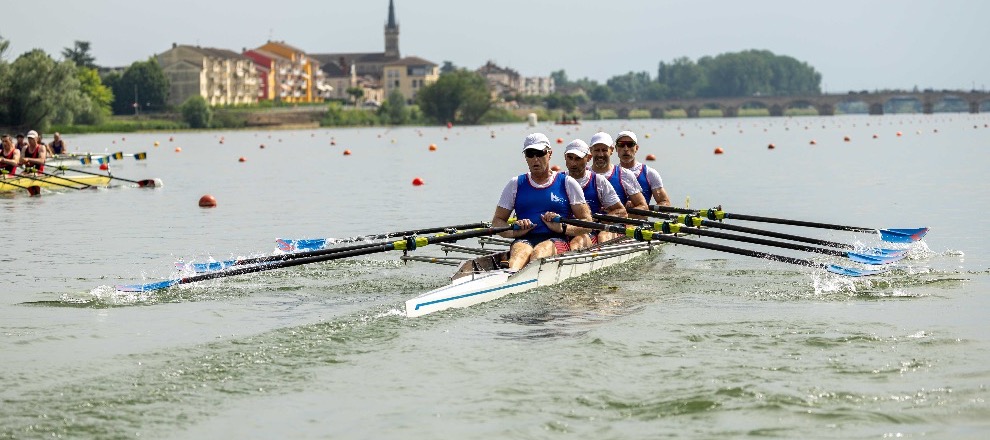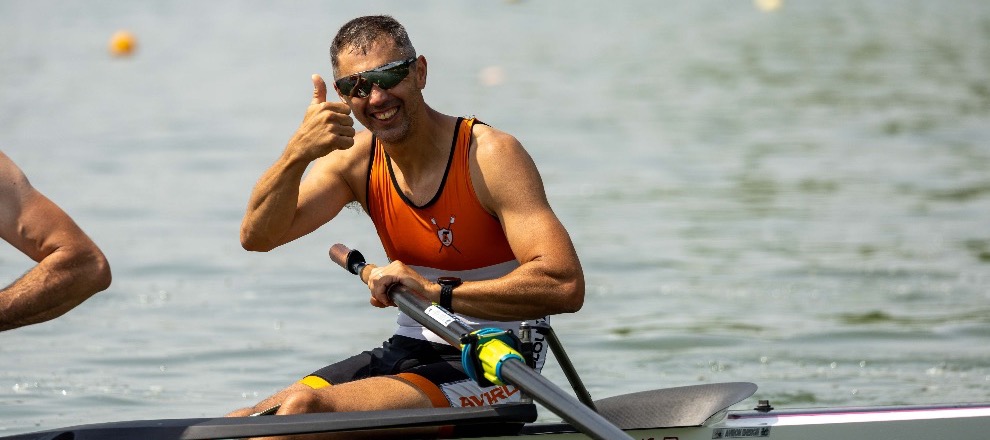Les prochains championnats du monde d'Aviron Indoor auront lieu à Paris en février 2020. De l'élite, aux crossfiters en passant par les passionnés de l'ergomètre, découvrez tous les mois le portrait d'un ou d'une athlète pratiquant la discipline.
Pouvez-vous vous présenter ?
Agathe Denis : Je suis en catégorie Femme Poids Léger. Depuis un peu plus d’un an je fais de l’aviron en France, mais j’ai débuté pendant quand j'étais au lycée, chez moi, au Texas. Pendant mes années d’université j’ai ramé avec l’équipe de l’université de Wisconsin, puis je suis venue en France où je me suis entraînée pour les championnats u23 à Poznan. Depuis, je rame avec mon club près de Paris.
Pour vous, qu’est-ce que l’aviron indoor ?
A.D. : Pour moi l’aviron indoor est un outil de travail essentiel pour l’aviron. L’ergomètre est utile car ça donne beaucoup de données sur nos performances et nous donne une meilleure idée de notre état de forme. En plus, quand il y a beaucoup de vent, de courant, ou s'il fait trop sombre dehors pour ramer l’ergo est le meilleur moyen de travailler sa technique et son cardio.
Citez 3 raisons de pratiquer l’aviron indoor.
A.D. : L’aviron indoor est une bonne forme d’entraînement qui donne beaucoup de repères pour travailler le côté physique et c'est super pour travailler l’aspect mental du sport car avec toutes les données on peut s'évaluer et se comparer, ce qui donne une motivation pour toujours aller chercher plus loin. Enfin, c'est essentiel pour l’équipe de France et le haut niveau car les tests, comme le championnat de France d’aviron indoor, permettent de pouvoir observer le niveau des athlètes.
Quand et comment êtes-vous arrivée à l’aviron indoor ?
A.D. : J’ai commencé l’aviron indoor pendant le lycée, quand j’ai commencée l’aviron. Mon club utilisait l’ergo pour pouvoir apprendre le mouvement d’aviron aux débutants, et puis nous en faisions une fois par semaine !
À quelle fréquence pratiquez-vous l’aviron indoor ?
A.D. : La fréquence à laquelle je pratique l’aviron indoor dépend de la saison. Pendant l’hiver, en France, c'est 3 à 5 fois par semaine, au printemps c’est plutôt 1 à 2 fois par semaine. Mais quand j’étais au États Unis le lac sur lequel on ramait était gelé pendant des mois nous faisions donc de l’ergo au moins 8 fois par semaine.
Considérez-vous l’aviron indoor comme une activité physique complète, accessible ?
A.D. : Une des raisons pour laquelle l’aviron indoor est tant utilisé par les rameurs dans le monde, est dû au fait que ce soit un sport complet.
Pourquoi venez-vous vous confronter lors de championnats d’aviron indoor ?
A.D. : Je suis venue faire le championnat d’aviron indoor parce que c’est une étape requise pour pouvoir essayer d'intégrer l’équipe de France, et puis pour voir comment cela se passe en France.
Les championnats du monde d’aviron indoor auront lieu à Paris en 2020. Quelle a été votre réaction ?
A.D. : Je trouve ça génial que les championnats du monde d’aviron indoor aient lieu à Paris en 2020, tous les meilleurs seront là.
Pourquoi ceux qui vous lisent devraient participer ?
A.D. : C'est une super expérience avec beaucoup d’ambiance. Pour les gens qui viennent de l'étranger, ils vont pouvoir se mesurer aux pays dont l'aviron indoor prend une place prédominante dans le programme, à l'image des USA. En plus, c’est une bonne excuse pour passer un week-end à Paris et visiter un peu.
Donnez-nous 3 adjectifs qualifiant les championnats d’aviron indoor :
A.D. : Compétitif, amical et difficile.
English version below
Next Indoor Rowing World Championship will take place in Paris in February 2020. By then, we will present you each month Indoor Rowing athletes including professionals rowers, CrossFit athletes and ergometer specialists.
Could you introduce yourself ?
A.D. : My name is Agathe Denis, I am a lightweight rower currently rowing in France. I started rowing in America in my hometown of Austin Texas, then moved to he University of Wisconsin Madison were I rowed on their lightweight team for four years. After that I came to France where I trained for U23s in Poznan. I stayed in France and am continuing rowing with my club near Paris. So far I have only ever competed over 2000m in a formal erg competition!
What is indoor rowing to you?
A.D. : To me erging is an essential tool for rowing. I️t is useful to the rower because it gives you a lot of data on our performances and can give us a good idea of what shape we are in. On top of that, erging is the best alternative for rowing when the conditions are bad, or if it’s too dark to row, because I️t gives you the possibility to get a good workout in while also working on technique.
Give us three reasons to practice indoor rowing
A.D. : Indoor rowing is a great way to train and gives you a good idea of where you stand and what you need to work on physically. Erging is also great to be able to work the mental side of sports because I️t gives you the opportunity to compare yourself to your past performances and to others on your level, which creates a good motivation to continually search for more. Erging is essential for the French National team and elite level rowing in general, because you are often judged based off of erg tests such as the French National Indoor Rowing Championships.
When and how did you start practicing indoor rowing?
A.D. : I started erging in high school, when I started rowing. My rowing club used erging as a way to teach the beginners how to row, and then from there we continued erging at least once a week.
How often do you practice indoor rowing?
A.D. : The frequency with which I erg depends a lot on the season. During winter in France I erged about 3-5 times a week, and now that spring has arrived I erg a little less, usually 1-2 times per week. However when I was in the United States the lake on which we rowed would freeze over for several months, so as a result we erged everyday, usually adding up to a minimum of 8 times a week, although it often was more than that.
Do you think that indoor rowing is a complete and accessible physical activity?
A.D. : One of the main reasons erging is used so much by rowers around the world is because it is the best way to work out all of the main muscle groups, especially those which are used in rowing.
Why do you compete in the indoor rowing championship?
A.D. : I came to the indoor championships because it is a necessary step to be able to be in contention for the French national team, and to see what it was like to participate in one of these competitions in France.
The indoor rowing world championship will take place in Paris in 2020. What was your reaction?
A.D. : I think it is great that both the indoor world championships, all best rowers we'll be there.
What reasons can you give the readers to participate/Why should the people reading this feel the need to participate?
A.D. : It was a great experience, with a lot of good vibes, and would be an especially interesting experience for those coming from more erg dominant programs, such as the United States, because it would give you an opportunity to compare yourself to the best of foreign competitors coming from a less erg dominant program. Also it would be a great excuse to spend a weekend in Paris and do some sightseeing.
Give us three adjectives to qualify the indoor rowing championship:
A.D. : Competitive, welcoming/friendly, and tough.













